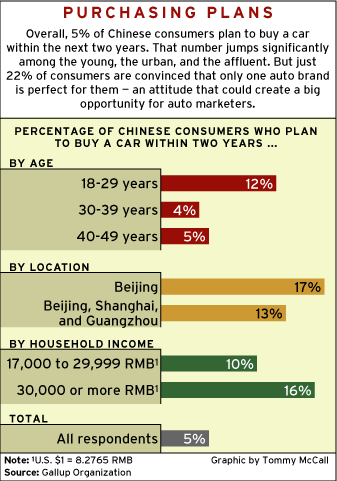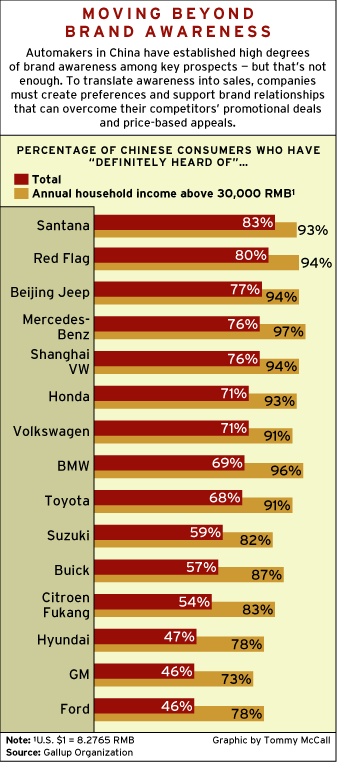After a year of intoxicating sales growth, the automobile industry in China saw a disconcertingly sharp drop in new-car sales in 2004. Official figures reveal that the 75% sales increase that took place in 2003 plummeted to a mere 15% last year. The 2004 results were especially disappointing for many auto manufacturers who had been busily ramping up production and expanding distribution to capitalize on what they hoped was a huge demand for new cars.
Of course, 15% growth is simply a number -- one that must be viewed through the lens of manufacturer expectations. As BMW's Helmut Panke pointed out, his company's 11% sales growth in China during the first 10 months of 2004 outpaced the company's sales elsewhere in the world. Even at a scaled-down 15%, China's sales increase could still be viewed as impressive. After all, car sales in the United States grew only 1% during that same time period -- and China still reported more than 5 million vehicles sold in 2004.
Anticipating continuously escalating growth, automakers in China have expanded their production at a rate far above that 15% annual growth figure. And more manufacturers have been entering the market, ready to compete aggressively for their piece of this attractive pie.
 |
The high cost of driving
The problem isn't that fewer Chinese consumers now want to own a car -- it's that the cost of a new car is well beyond the reach of most consumers. Vehicle price tags can easily represent four times the annual income of even an affluent Chinese household.
To address this purchase-price hurdle, major automakers have been slashing their new car prices by 10-15% while introducing "bare bones" subcompacts. However, the performance and quality of these stripped-down models is debatable, and as Yugo learned, any brand that fails to keep its basic promises won't prosper long term. Still, some analysts are forecasting that car prices in China will be cut by half within the next four years
Currently, auto ownership in China is very limited -- only 2% of Chinese consumers own a private car. But results from the Gallup Poll of China reveal that there are important pockets of higher-potential consumers, enough to motivate auto manufacturers to continue their investments. Despite the high price tag, 5% of Chinese consumers indicate that they plan to buy a car within the next two years. And that percentage is appreciably higher among the young, the urban, and the affluent. (See graphic "Purchasing Plans.")
Automakers go to battle
To market to these pockets of high-potential prospects, some auto manufacturers have already established a marked degree of brand preference. Twenty-two percent of Chinese consumers feel that one car brand stands apart from all the rest -- although they don't agree on which one. That's an increase from the 17% who felt that way in 1999.
These percentages are even higher among the more affluent and urban-dwelling Chinese consumers. Of course, that also means that somewhere between two-thirds and three-fourths of key car-buying prospects remain unconvinced that only one auto brand will meet their needs. This sets the stage for today's price wars and for continued intense competition among automakers.
Due to the automakers' marketing investments, many auto brands have shown impressive increases in consumer awareness. In just the past five years, recognition of some brand names has risen significantly: Awareness of Buick leaped from 13% to 57%, BMW awareness jumped from 35% to 69%, and VW's brand awareness rose from 42% to 71%.
 |
But the challenge facing these competing automakers is clearly reflected in the brand recognition and familiarity levels among key buyer prospects. The consumers who might be most able to afford a car -- those in affluent households with 30,000+ RMB annual income -- are well aware of all 15 brands measured in Gallup's China Poll. Brand name awareness alone will not determine consumer choice in China, even though awareness-leader Santana -- because of its established and pervasive presence in the country -- is also currently China's market share leader. (See graphic "Moving Beyond Brand Awareness.")
Beyond awareness: the marketing challenge
Having already established high degrees of brand awareness among key prospects, Chinese automakers must begin to move beyond this basic marketing requirement. They must now create preferences and support brand relationships that are strong enough to overcome the promotional deals and price-based appeals of their competitors. And they must provide quality vehicles that deliver on their basic performance promises.
Given the clutter of competition and the pervasiveness of price offers, this is hardly a simple task. However, it's exactly what will be required for an automaker to achieve sustained success in China. Cutting prices is simply a short-term requirement to compete in what will no doubt be an auto-marketing marathon. It's not clear who the winners will be, but it's apparent that the race will be hotly contested.
Results of this survey are based on a total of 3,597 hour-long, in-person, in-home interviews that were conducted across China -- 3,074 during June and July and an additional 523 in November 2004. Interviewing was conducted throughout the country -- that is, across each of China's 22 provinces, 3 municipalities, and 5 autonomous regions.